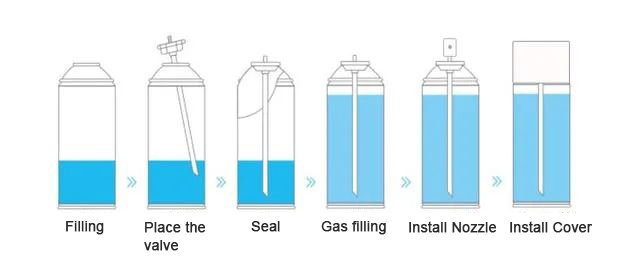Aerosol cosmetics are the systematic integration of traditional cosmetics formula technology and aerosol technology, not a simple physical addition. Therefore, the entry threshold of aerosol cosmetics industry is high.
The difficulty lies in: on the one hand, aerosol cosmetics need to master not only the general cosmetics formulation technology, but also the aerosol integrity technology.
For example, in the formulation research and development, aerosol cosmetics not only need to consider the compatibility of the material and the propellant, but also need to adjust the formulation according to the shape of the sprayed material, such as foam, fog, emulsion, etc; In addition, the aerosol valve system is also a key factor affecting the shape of the ejected material.
On the other hand, because many aerosol cosmetics use flammable and explosive projectiles, the production workshop of aerosol cosmetics should not only meet the GMP good production practice for cosmetics, but also meet the double standards of the safety production practice for hazardous chemicals.
There are two kinds of packaging forms of aerosol cosmetics, single-packaging and Bag-on-Valve. There are certain differences between the filling methods used in the two packaging, including the specific filling methods, advantages and disadvantages.
Filling process of single packaging

The canning process of aerosol cosmetics canned in a single packaging is as follows:
first, add the material into the material tank, then press the valve, and then inject the propane butane, dimethyl ether or other irritant gas as the propellant into the material tank through high pressure to mix with the material, and then install the promoter (nozzle) and bottle cap.
When in use, press the promoter (nozzle) to open the valve, and the propellant will be discharged from the tank to form a negative pressure, thus bringing out the material to form a mixed spray.
Advantages
1. The production process of single packaging is very mature, so it is widely used. In addition to spray, sunscreen and gel can be used. Besides, there is no great requirement for the material of the bottle body, aluminum can, plastic or acrylic can all be used.
2. The production process is simple and the price is relatively affordable.
Disadvantages
1. Using propane, dimethyl ether and other flammable and explosive gases as propellants, improper use will cause combustion and explosion, and it is not allowed to take aircraft, high-speed rail and subway;
2. Because of the mixture of gas and material, the gas and material will be discharged at the same time when pressing. For people with sensitive skin, it is easy to cause allergy or damage the skin barrier;
3. The mixed packaging of material and propellant is easy to be polluted by the external environment, and the material is not pure enough.
4. There is sediment. Shake it before use. Press it several times during use. The bottle body can only maintain a horizontal fixed angle when spraying.
Filling process of Bag-on-Valve

There is another capsule valve containing the body in the Bag-on-Valve aerosol cosmetic body tank.
The filling process is as follows: first put the valve with the capsule into the tank, then press the valve tightly and fill the propellant gas.
Generally, compressed air (purified), nitrogen, etc. are used as propellants. After that, the liquid is injected into the bag through the filling machine, and the nozzle and outer cover are fastened.
The bag valve is completely isolated from the tank body, and the valve is opened when the tank is filled with air.
The compressed gas in the tank compresses the bag to press the raw material out of the tank, and the compressed gas remains in the tank.
Structure of Bag-on-Valve aerosol can

Advantages
1. The propellant uses nitrogen instead of traditional dimethyl ether and propane butane as the propellant, which has higher safety. The aluminum tank with 99ML capacity can be used to carry high-speed rail and aircraft.
2. The material is isolated from the propellant and is not easy to be contaminated. It does not need to add other preservatives, so it will not cause harm to the skin.
3. Multiple protection systems are formed by valves, four-layer vacuum bags and aluminum cans, with high sealing performance, the material is not afraid of oxidation, light, heat and cold, secondary pollution.
4. The binary spray plus the atomization treatment of the inner material makes the sprayed material form a fan shaped nano atomization, which is easier to be absorbed by the skin, even and soft.
5. The material body is separated from the gas, no sediment, no shaking, spray as you go.
6. Once pressed, spray smoothly to the end without repeated pressing, and spray freely without dead angle.
7. The material emptying rate reaches 99%, which does not cause waste.
8. It is lighter and more convenient to carry than ordinary spray.
Disadvantages
1. The production process of Bag-on-Valve is relatively complex, and it must be aluminum cans. The production cost is relatively high, and the production consumption is large.
2. At present, due to the predominance of Bag-on-Valve aerosol cosmetics over single-package cosmetics, Bag-on-Valve is the trend. Many domestic cosmetics manufacturers have begun to spend money on the development of Bag-on-Valve filling production lines, while driving equipment manufacturers.
